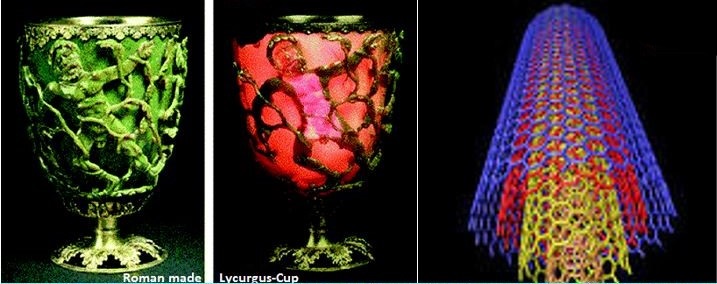
Nanotechnology - From Ancient Period to Present
Advanced Science

930 views
0 likes
You will need to sign in before you can comment or like.
Advancements in science has been observed since ancient ages.
By creating new pathways and digging unexplored natural phenomena, human civilization has been led to scientific advancement.
The emergence and diversification of nanoscience and nanotechnology is one of the greatest achievements of this century.
The vindication of this concept started with the famous quote
There's Plenty of Room at the Bottom,
by physicist Richard Feynman at the American Physical Society meeting at CalTech in 1959.
Nanoscience includes the study of materials that have sizes between 1-100 nm with at least one dimension.
However, nanomaterial based technologies are not new - they have been exploited inadvertently since ages.
For example, the Lycurgus cup (present at the British Museum),
made in Rome around 290-325 AD, shows two different colours - it appears green
when lit from the front but blood-red when lit from behind - a property that puzzled scientists for decades.
Nanoscience has revealed that this is due to the
gold and silver nanoparticles present in the cup.
In Greco-Roman period, black hair colouring dye was used, consisting of PbS nano crystals.
Besides, carbon based nanomaterials, a promising class
of nanomaterials has also been prominent since classical ages.
 The presence of carbon nanotubes and cementite nanowires in the ancient Damascus sabres
provides extraordinary mechanical strength and a sharp cutting edge. Damascus blades were
first used by the Crusaders when fighting against Muslims.
Present research has also proven carbon nanoparticles to be safe and omnipresent in various food items
such as bread, biscuits, jaggery, cornflakes, chicken etc. without causing any health hazards.
These particles have unique fluorescence properties and are used in various biological applications.
The presence of carbon nanotubes and cementite nanowires in the ancient Damascus sabres
provides extraordinary mechanical strength and a sharp cutting edge. Damascus blades were
first used by the Crusaders when fighting against Muslims.
Present research has also proven carbon nanoparticles to be safe and omnipresent in various food items
such as bread, biscuits, jaggery, cornflakes, chicken etc. without causing any health hazards.
These particles have unique fluorescence properties and are used in various biological applications.
Today, nano-technology has ripened into the technology of this century.
Nano science has applications everywhere - from medical to agricultural, electrical to industrial.
Transportation to telecommunication systems might also see implementations in the near future.
The discovery of graphene and carbon nanotube mark one of the important breakthroughs of modern science.
These carbon based nano-structures got Nobel prizes - in 1996 for buckminsterfullerene and in 2010 for graphene,
and promise revolutionary developments in electronic and opto-electronic fields.
In this regard, researchers recently built the world's thinnest light bulb using graphene as a filament.
In the near future, such technologies could be used in transparent and
flexible lighting displays. Also, it will help to develop photonic
processors that are much faster than conventional chips.
Comments